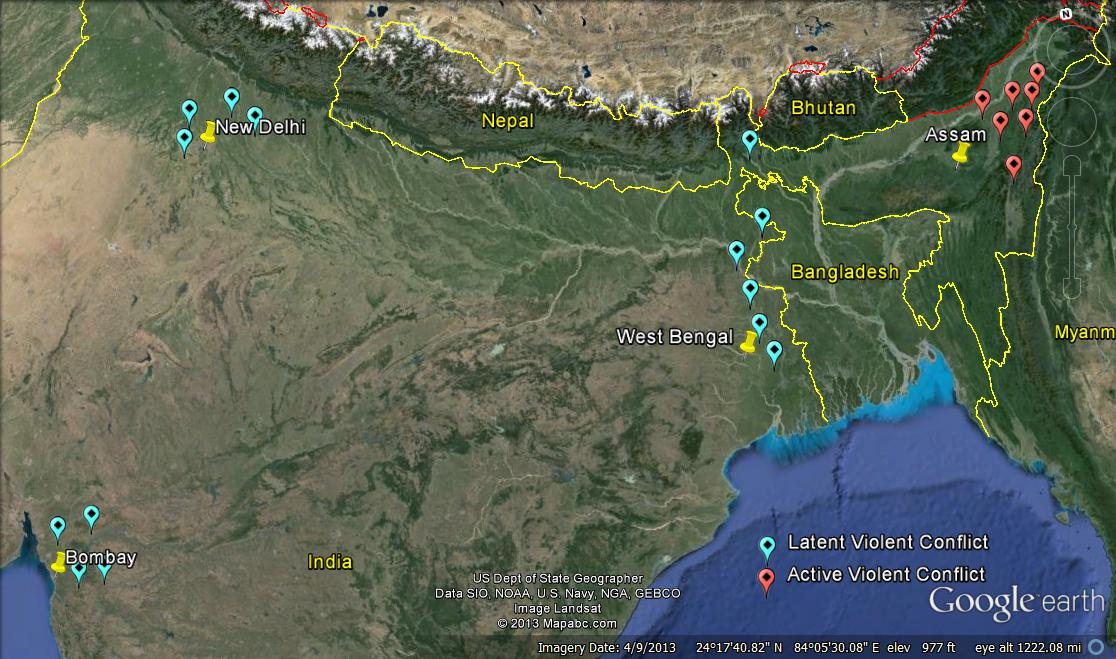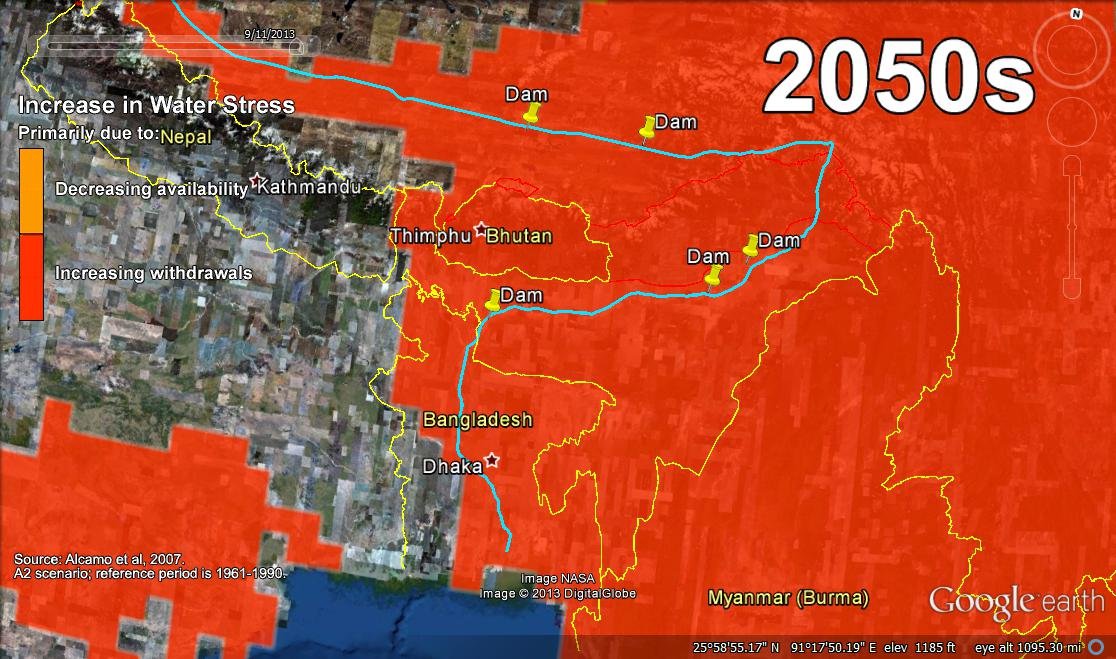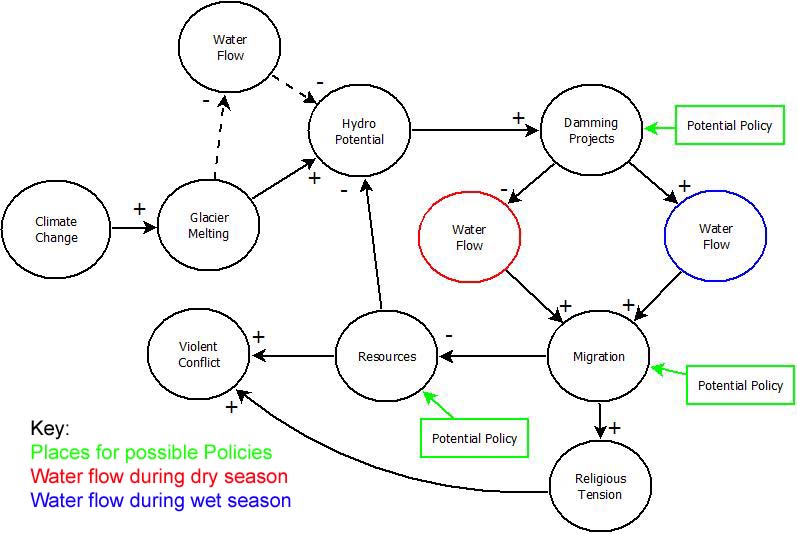
| ICE Case Studies
|
The Brahmaputra River, Inter-State Conflict and Climate Change |
I.
Case Background |

As climate change progresses and India and Bangladesh continue to develop there has been a continued strain for natural resources between the two countries. Specifically, the Brahmaputra River has become one of the main points of conflict between the two nations; and as climate change progresses, the relationship between the two nations becomes more and more strained. India’s potential to develop relies heavily on their ability to harness the power of the river, and have recently implemented many development projects that will build dams along the river to harness the river's hydrological potential. However, Bangladesh’s citizens rely on the river to sustain their lives. Tension in the region has been mounting for decades and if policy is not implemented soon disaster is likely to ensue.
One of the most pressing issues today is the Brahmaputra River conflict. This transnational river flows from the Himalayas through India and Bangladesh, and is the main life source for many people. However, modern day challenges have made politicians realize the river’s potential for economic growth and the security of their citizens. As India continues to grow they plan on building dams to harness the river’s hydropower potential.
India is also trying to harness the power of the great Brahmaputra, by using the flow of the river to generate hydropower. India has a 95% potential for developing hydropower because of the Brahmaputra River, but currently they have only developed 20%. India is looking towards hydropower for their main source of energy in the hopes that it will help them to develop as a country and boost their position in the world. They have yet to make any truly threatening dams, but with an increasing demand for energy it probably won’t be long until one is constructed. In addition to dams, the Indian government is currently in the developing stage of the River Linkage Project, which will divert excess waters from the Northeast region of the country to the western and southern states, where droughts plague the land. India has big plans to utilize the Brahmaputra River without any regard to how it might affect their downstream neighbor Bangladesh.
While India constructs these dams, Bangladesh suffers from the repercussions. During the dry season the Bangladeshi people face severe drought and have been forced to relocate and find other water sources; while during the rainy season the region faces severe flooding killing thousands of people and submerging homes. Although agreements have been made between the two countries, India has not abided by them. Bangladesh’s citizens and its government have begged the Indian government to stop what they are doing, but to no avail.
Many of the causes of the Brahmaputra River conflict are because of human intervention, but the severity of the issues is exacerbated by climate change. The Brahmaputra provides much more than just hydroelectricity waiting to be developed it also provides the drinking water, water for agriculture, and a means of transportation for a majority of Bangladesh’s citizens. Water is a holistic element that is necessary for food production, hygiene, and hydration. Climate change is affecting people’s necessity for water in Bangladesh because both the dry season and the rainy season are becoming more extreme. During the dry season citizens are more dependent on the Brahmaputra to provide water for all their needs, because there is not a sufficient amount of water from other sources. However, when the dry season ends the Bangladeshi people face a whole new set of water related issues. During Southeast Asia’s other major season, monsoon season, Bangladesh and India experience extreme rainfall causing the Brahmaputra to flood. When the dams built upstream get too full, governments release the water thus flooding areas downstream. The Bangladesh government now has to face two negative effects of climate change during the rainy season. The first adverse affect is the increased rainfall which causes India to release excess water, drowning thousands of Bangladeshi people each year.
Since the 1950s the relationship between India and Bangladesh—formerly East Pakistan—has been strained over the use of transnational rivers. Many citizens of Bangladesh and India depend on the international rivers as a way to sustain their lives, economy, and ecosystems. The governments have tried to reach an agreement that both sides consent to, however the political power of India within the region has prevented one from being made. Bangladesh’s water insecurity started back while they were still a part of Pakistan, over the Ganges River. India helped the newly formed nation during their independence movement from Pakistan, so the government had high hopes that the two nations would work peacefully cooperate, especially on issues regarding water. However, in 1975 the relationship between the two countries started to deteriorate due to India’s immense power within the region. India proposed various damming programs that would either change the path of the river or greatly reduce the flow into Bangladesh. If India built dams along the Brahmaputra, we would see approximately a 20% reduction water flow which would dry out many areas. Bangladesh is an agrarian society that depends on the Brahmaputra for irrigation, especially with rice during the dry season. 80% of Bangladeshi farmers grow rice as their main crop, requiring copious amounts of water to sustain itself and lead to a successful harvest.
Between the 1970s and the 1980s the majority of migrants went to the northeastern corner of India, known as Assam, because of its petroleum industry and tea estates. The formation and the cultural identity of India relied heavily on it being a Hindu state. However, the majority of Bangladeshi immigrants are Muslims, and the native Hindu population of Assam is rapidly becoming outnumbered. Although religious identity has been the sole reason for conflict between India and Bangladesh, combining it with the fierce competition for resources has caused violent conflict in Assam, and has the potential to increase violent conflict in other regions of India.

Like many river disputes, this conflict is a transnational issue between India and Bangladesh. In India, many of the areas where conflict has erupted have been cities and territories where Bangladeshi immigrants were forced to relocate to. Most of the immigrants moved to the Northeast region of India, which Bangladesh almost entirely cuts off. This region, known as Assam, is where the majority of conflicts break out. These conflicts have already become violent, and are likely to continue being violent as more and more Bangladeshi people go there.
Other areas of tension are along Bangladesh’s western border with India as well as urban areas such as New Delhi, Bombay, and West Bengal. Currently, these area’s are only experiencing latent conflicts, but as more people move to the area and the concentration of people increases, especially in the urban areas, there is greater potential for more violence.
All of the conflict between Indian citizens and the immigrants from Bangladesh can be traced back to areas along the Brahmaputra River. In Bangladesh, the people who are most affected are the people who live along the river. This population has now become the migrant population in India. However, the damming projects that are forcing the Bangladeshi people to immigrate are located along India’s portion of the Brahmaputra River.
The scale of the Brahmaputra River conflict involves a range of members of society in both India and Bangladesh. This is a multilayered problem where the Indian and Bangladeshi governments are fighting each other on the political playing field, while violent conflict breaks out among the poorest in the nations. For years the Indian and Bangladeshi governments have been disputing over India’s water damming policies. In addition, conflict has broken out between the rural communities in the Northeast portion of India and the Bangladeshi immigrants.

 Type of Environmental Problem
Type of Environmental Problem
This environmental problem mostly concerns water. Water is vitally important for human existence. However, as climate change persists these concerns will become greater. These concerns will manifest themselves in both the dry and rainy season.
During the dry season many people who live by the river have noticed a continual decrease in water flow. They depend on the rivers flow for many reasons, but most importantly for food and water. As climate change persists, Bangladesh’s water security will decrease, resulting in a lack of food, water, and economic resources.
During the rainy season the glacier melting that created the Brahmaputra River will drastically increase, creating a surplus of water in India’s reservoirs. This water will then be released in massive quantities downstream, wiping out many communities along the river. This has also increased the water salinization, making a lot of the water too contaminated to drink.
Both India and Bangladesh are very hot countries. Although they both have coasts along the ocean and have many rivers, these countries can experience severe drought. They typically experience six seasons throughout the year: summer, the rainy season, winter, autumn, the dewy season, and spring (but not anymore).
As climate change progresses, the variety in seasons will diminish. This region has already lost the spring season and the autumn, winter, and dewy season are getting shorter every year. As these seasons fade away the region will be left with just the summer and rainy season.
Many of the conflicts have occured in Assam, the northeast part of India. However, latent conflicts where evidence of this conflict also takes place along Bangladesh's eastern boarder with India, and in the urban areas of New Dehli, West Bengal, and Bombay.
In addition, many of India’s damming projects affect downstream communities in Bangladesh.

This conflict is both a civil and international conflict. On the international level that Bangladesh and Indian governments are disputing over an agreement to monitor the river. Bangladesh wants to create a cohesive agreement that fairly shares the river. India, on the other hand, wants to instate its sovereignty and utilize that Brahmaputra’s hydro-electrical potential to the fullest. At the civil level, there have been many disputes between the Indian residents and the Bangladeshi immigrants that relocate to their territory.
The level of this conflict is extremely high. In many areas violent conflict has broken out, while latent conflicts fester. As more and more Bangladeshi people relocate to India, it is likely that this conflict will continue to escalate. Conflict that eventually break out will either be because of political reasons and tensions between the two civilizan groups. Although it is impossible to say for sure, what will happen in the future because of political changes, this is the most likely scenario.
The fatality level of this dispute is fairly high. The Indian communities have already showcased at least one massacre towards the Bangladeshi immigrants, and more than 4,700 immigrants have died.


Climate change is the start of this issue and leads to glacier melting from the Himalayan glacier that formed the Brahmaputra River. As the flow from the glacier increases there are two outcomes. The increase in water flow will lead to an increase in hydrological potential. The second result is a lag in the future where the water flow actually decreases. The decrease in water flow will then result in a decrease in hydrological potential. The hydrological potential leads to an increase in damming projects, which is where the first opportunity for a policy is. The damming projects will have a negative effect on the water flow during the dry season, where the amount of water available will decrease. During the rainy season, the water flow will increase and there will be an increase in water. Both of these problems will lead to citizens immigrating from Bangladesh to areas in India. This is where the second potential policy lies. This immigration will cause an increase in religious tension between the Indians and the Bangladeshis, and it will also reduce the amount of resources available. The decrease in available resources also means that the hydropower potential will also decrease. These will both eventually lead to violent conflict. A potential policy can be implemented to govern the management of natural resources to potentially alleviate the violent conflict.
Sub-state – Most of the violence has occurred between the Indian citizens and the Bangladeshi immigrants
Bilateral – Both the Indian and Bangladeshi governments are feuding over the Brahmaputra River and effective regulatory policies.
This dispute is currently still in progress and probably will be for a while. I have provided the two most likely scenarios of how this conflict will pan out.
The best way to solve a violent conflict is to prevent it from happening. In order to prevent further conflict from arising in this region, many actions could be taken. The most effective would be to put a halt to India’s upstream damming projects, which would allow the Brahmaputra to flow naturally and provide adequate water to Bangladesh. However, if India insists on going through with the damming projects, then a multilateral agreement between Bangladesh and India is another possible solution. This agreement would facilitate the sharing of information about the river, and also the sharing of water resources. Finally, since much of the conflict that has already arisen in the region has been caused my migration, India would greatly benefit from a stronger immigration policy that would ease the Bangladeshi people into Indian society better. This will result in a compromise between the two countries.
If the events continue the way they are now, without any kind of interference, then India will likely continue to monopolize on hydropower provided by the river. The influx of Bangladeshi immigrants in India will continue to increase. Tensions between the two nations will keep on rising, while India likely continues to develop. Bangladesh will be forced to keep struggling just to get by. However, this is assuming that the entire country of Bangladesh doesn’t become completely submerged underwater because of climate change and rising sea levels. In this case India is likely to win the conflict, while Bangladesh loses.

Kura-Arals Basin: Diplomatic Degredation and the Compounding Impact of Climate Change
Kosi River in Tibet and Climate
The Brahmaputra: Water Hotspot in Himalayan Asia
India, China, and Bangladesh: The Contentious Politics of the Brahmaputra River
Proposed Diversion of Brahmaputra River by China
Impacts of Climate Change in Bangladesh
Swain, Ashok “Displacing the Conflict: Environmental Destruction in Bangladesh and Ethnic Conflict in India” Journal of Peace Research Vol. 33 No. 2 (1996) pg. 189-204
Saleyhan, Idean “From Climate Change to Conflict? No Consensus Yet” Journal of Peace Research Vol. 45 No. 3 (2008) pg. 315-326
